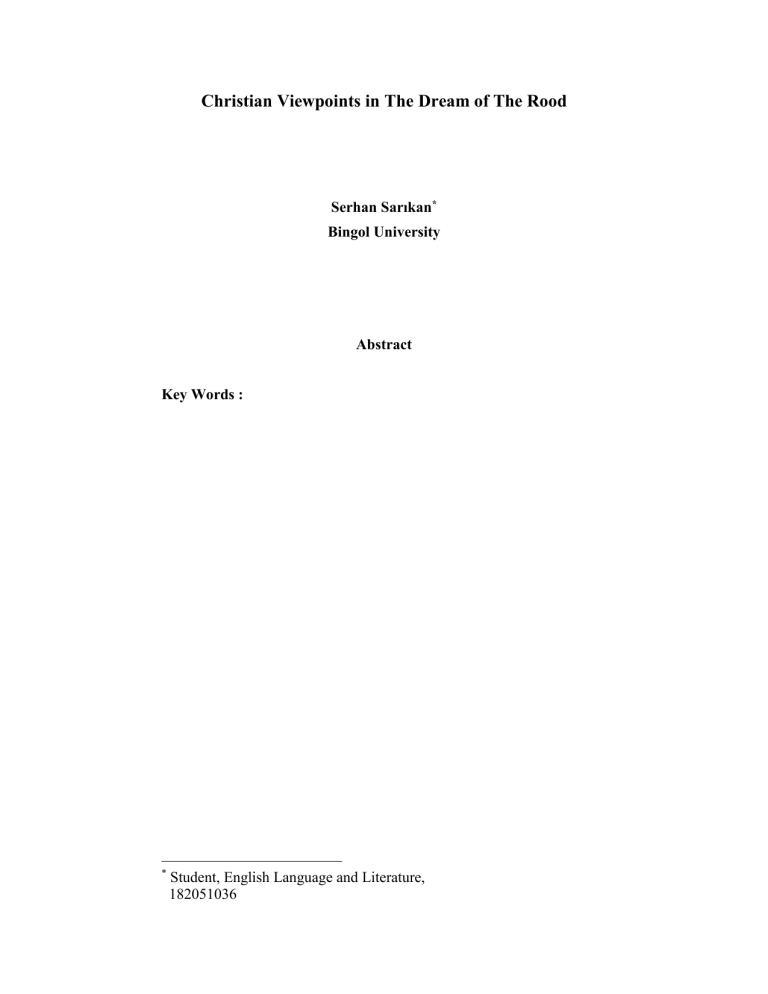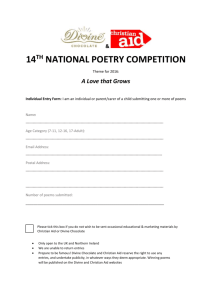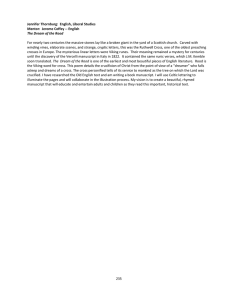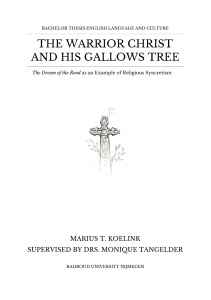
Christian Viewpoints in The Dream of The Rood Serhan Sarıkan* Bingol University Abstract Key Words : * Student, English Language and Literature, 182051036 INTRODUCTION “Most Old English poems are recorded without authors, and very few names are known with any certainty.”1 Old English Poetry2 (c.650 – c.1100) is a series of addictive works of literature thanks to it’s heroic themes, elegiac mood along with long lines of alliterative lyrical characteristics. Anglo-Saxon poetry is not only an valuable source that not only brings a light to struggling times of invaders that are busy bickering, frightening each other while vying for control of England and later on their conversion to christianity3. Also, it is a source that contains centuries worth of historical context, documented catholic church scripts, culture, and poetry. Majority of the Anglo-Saxon poems shares some certain characteristics at certain times, these are mainly focused on heroism, kings and their achievements, tensions between religions while keeping it elegiac mood. These characteristics can differentiate the works in terms of viewpoints. The other parts of the Anglo-Saxon Literature is not recorded as manuscripts written on artifacts and haven’t kept alive under expensive conditions but still, some of them survived. 1 Cameron Angus. Anglo-Saxon Literature, Dictionary of the Middle Ages, p .274. Anglo-Saxon literature 3 Year 597. St.Augistine’s arrivel to Kent and beginning of converstion to Christianity. 2 “A Vision of the Cross”4 Same as the all the other Old English poems, original title The Dream of the Rood is not a title in it’s original manuscripts. This essay aims to blow the dust off from the Anglo-Saxon literature’s finest and make the readers interested the poem same way Anglo-Saxon literacy did hundreds of years ago to people that lived in today’s England. 4 Bruce Mitchell, A Guide to Old English, 8th ed. 1949 The Dream of the Rood The Dream of the Rood is one of the earliest examples of dream or vision based poems in that period. The separating factors of pagan competing against christian culture was a concern for the Christian Anglo-Saxons. Anglo-Saxon immigrated to England reflected traditional characteristics which originated from Germanic works1. Germanic poems and Pre-Christianity poems show signs of celebrating courage and bravery, aggressiveness. Meanwhile, christian works were leaning towards to love, kindness or loving the kindness and self-sacrifice. The Dream of the Rood is not a poem shares opposite views but it mostly tampered with Christian messages to make people convert. This itself makes the poem finest of the religious poems but at the same time lacks the diversity of opposite values in terms of Pagan and Christian viewpoints thus making Pre-Christian and Christian culture not be able to seperated from one individual line to another. The Dream of the Rood’s solemn purpose is a tool to convert AngloSaxons to Christianity.2 In the process of doing that there is some pagan culture to look out for, after all it has been mainly written for that audience: “I had endured the work of evildoers...The image of the tree which has been used to make cross starts speaking. Signs of a Germanic culture that still continues. Reader is learning the story from tree’s perspective. It’s an example of using paganism values. “I was taken from my stump. Strong foes hewed me to the shape they wished to see.” “They pierced me with dark nails... They mocked us both together.” Another way of tree narrating the story line, this time tree is with the Christ himself and loyal to him. “The tree of glory on which Almighty God suffered for mankind’s many sins and the deeds Adam did of old.” Here, it’s more of Christian related characteristics. Resurrection. But after that poem follows a both mixture of Pagan and Christian values to make it even more stronger. “Man is who in the name of the Lord would taste bitter death as he did on the Cross.” To conclude, Dream of the Rood implies that Christ is a divine hero of an battle. Warrior that has only one purpose, conquer the evil and the good using the Cross made from the tree. The Dream of the Rood is an essential part of Christianity and poems that follows that direction. What makes it even more interesting to read is giving a message using different cultures, narrators.3 As a final note, unlike other examples, the dying of Christ is actually the essence and starting point of the fight between good and bad. It is also written by two different viewpoints but not as separate, together. As the Anglo-Saxons is familiar with the fights and battles, mixing this altogether with the Christian values is a very strong way to accomplish conversion. 1 Heinrich Härke, Anglo-Saxon Immigration and Ethnogenesis, p .1–28. 2 Meyer Schapiro The Religious Meaning of the Ruthwell Cross, 1944, p .26 3 Del Mastro The Dream of the Rood and the Milita Christi: Perspectives in Paradox. 1976, p .170-76 First narrator is at (lines 1-27) Second (28-121) Third (122-156)






